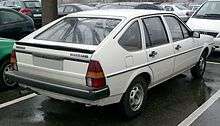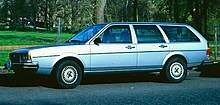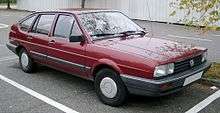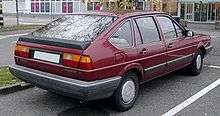Volkswagen Passat (B2)
The Volkswagen Passat (B2) is an automobile which was produced by German manufacturer Volkswagen from 1981 to 1988. It was the second generation of the Volkswagen Passat. The platform was slightly longer than the preceding Passat (B1). As with the previous generation, it was based on the platform of the Audi 80; the corresponding B2 version of which had been already launched in 1978. The Santana was also manufactured in China, Brazil, Mexico (as the Corsar, from 1984 and 1988) and Argentina (as the Carat between 1987 and 1991). In Brazil and North America, the Santana station wagon was sold as the Quantum. The Passat saloon and estate were produced in South Africa for their local market until 1987. The production of Passat B2 in China ended in 2012.
| Volkswagen Passat (B2) | |
|---|---|
Volkswagen Passat B2 Hatchback (1980–1985) | |
| Overview | |
| Also called | Volkswagen Corsar (Mexico) Volkswagen Carat (Argentina) Volkswagen Santana (China, Brazil and Japan) Volkswagen Quantum (United States and Canada) |
| Production |
|
| Assembly |
|
| Body and chassis | |
| Class | Mid-size car / Large family car (D) |
| Body style | 2-door saloon/sedan (Latin America) 3-door fastback/hatchback 4-door saloon/sedan (Santana) 5-door fastback/hatchback 5-door estate/wagon |
| Layout | Longitudinal front engine, front-wheel drive or four-wheel drive |
| Platform | Volkswagen Group B2 |
| Related | Audi 80 (B2) Ford Versailles Ford Royale Volkswagen Quantum Volkswagen Santana |
| Powertrain | |
| Engine |
|
| Transmission | |
| Dimensions | |
| Wheelbase | 2,550 mm (100.4 in)[2] |
| Length | 3/5d: 4,435 mm (174.6 in)[2] Variant: 4,540 mm (178.7 in)[2] Santana: 4,545 mm (178.9 in)[2] |
| Width | 1,685 mm (66.3 in)[2] Santana: 1,695 mm (66.7 in)[2] facelifted Santana: 1,710 mm (67.3 in) |
| Height | 1,385 mm (54.5 in)[2] Santana: 1,400 mm (55.1 in)[2] 54.8 in (1,392 mm) (GL) 58 in (1,473 mm) (GL Syncro) facelifted Santana: 1,427 mm (56.2 in) |
| Chronology | |
| Predecessor | Volkswagen Passat (B1) |
| Successor | Volkswagen Passat (B3) |
Design

Body configurations included hatchback, Variant (estate/wagon) a three-box saloon, which until the 1985 facelift was marketed as the Volkswagen Santana in Europe. In most markets, the equipment levels were renamed from L/LS/GLS to CL/GL/CD. The four-wheel drive Syncro Variant was introduced in April 1984, initially only with the 2-litre five-cylinder engine. In August, the more powerful 2.2-litre option was added. In North America, the Passat/Santana was marketed as the Volkswagen Quantum, available in three-door hatchback, four-door sedan, and a wagon model, but the five-door hatchback was never marketed there and the three-door hatchback dropped after less than two years.

Like the previous generation, the B2 Passat was mainly sold with four-cylinder petrol and diesel engines. Unlike its predecessor, however, top-of the line versions received five-cylinder Audi or VW engines of 1.9–2.2 litres.[1][3] In addition to four- and five-speed manuals and three-speed automatic gearboxes, the Passat/Santana was also available with the VW concern's interesting 4+E transmission. This, also called the "Formel E", had an overdrive fourth and an even taller fifth gear, which combined with a freewheeling mechanism to provide better gas mileage but less impressive performance. Originally, this was the only five-speed transmission offered with the Passat B2.[4] An automatic stop/start was also available in some markets.
The four-wheel drive system used in the Passat Variant Syncro shared the mechanics of the Audi 80 quattro rather than the Volkswagen Golf Syncro. When first shown, at the 1983 Frankfurt Motor Show, the car was meant to be called the "Passat Tetra".[5] The Syncro's bottomplate was almost entirely different, requiring a transmission tunnel, a relocated gas tank, and no spare tire well (to make room for the complex rear axle assembly). Unlike the related Audi 80 quattro which used a reversed front wheel setup, the rear-axle was an adapted Volkswagen Transporter unit so as to retain a flat loading floor. Only the more popular estate was deemed worthy of reengineering, so as to not offer direct competition with the sedan-only Audi 80 quattro.[5] Syncro was also available in the North American market, only with the five-cylinder engine.
IRVW II
The IRVW II is a modified Passat B2 from 1980. It was built for research on fuel economy in automobiles.
1985 Facelift



In January 1985 the range received a facelift with revised bumpers, interior, and front grille. The hatchbacks versions also received a new rear design, with broad and slim taillights replacing the earlier tall and skinny units. It also has a small integrated spoiler at the rear, and a flush-mounted rear windshield for lower wind resistance and a less cluttered appearance.[6] The three-door hatchback was discontinued while the separate Santana nameplate was dropped in Europe. The saloon's front end was now the same as the hatchback and estate and the small price increase for the sedan was eliminated.[7] The Passat GT was a new model, available as a liftback or station wagon. The Variant was now also available with the smallest 1.3-liter engine.[7] The North American version, still marketed as the Quantum, received European-style composite headlamps.
The Passat Variant Syncro, after a few months in production in the pre-facelift design, was also updated along with the rest of the line. Its equipment and appearance was now aligned with the GT trim, including the alloy wheels.[6] All five-cylinder Passats received power steering as standard equipment, to mnimize the effects of this engine's greater weight.[6] Equipment levels were increased somewhat but were still spartan, even by the standard of the time. The mid-level Passat CL only now received indicator lights for the parking brake and brake fluid level, but these were still not installed in the Passat C.[8] In August 1985 a catalyzed version of the 2.2-liter five-cylinder Syncro was introduced, producing 120 PS (88 kW). In January 1986 the Syncro programme was further expanded with a C model, fitted with the catalyzed 90 PS (66 kW) 1.8-liter inline-four engine.
On 31 March 1988 production ended (although Syncro models continued in production until June) with 3,345,248 built in Germany. World production totaled approximately 4.5 million units.
References
- James M. Flammang (1994). Standard Catalog of Imported Cars, 1946-1990. Iola, WI: Krause Publications, Inc. pp. 639–642. ISBN 0-87341-158-7.
- Auto Katalog 1983. Stuttgart: Vereinigte Motor-Verlage GmbH & Co. KG. 1982. pp. 206–207.
- World Cars 1982. Pelham, NY: The Automobile Club of Italy/Herald Books. 1982. pp. 135–137. ISBN 0-910714-14-2.
- Sundfeldt, Björn (2 June 1982). "Klasskamp" [Class Struggle]. Teknikens Värld (in Swedish). Vol. 34 no. 12. Stockholm, Sweden: Specialtidningsförlaget AB. pp. 22–23.
- Verhelle, Tony (13 October 1983). "Frankfurt: vervolg en slot" [Frankfurt continued]. De AutoGids (in Dutch). Brussels, Belgium: Uitgeverij Auto-Magazine. 5 (106): 36–37.
- Visart, Etienne, ed. (7 February 1985). "De Volkswagen Passat 1985" [The 1985 Volkswagen Passat]. De AutoGids (in Dutch). Brussels, Belgium: Uitgeverij Auto-Magazine. 6 (140): 12.
- Visart, ed., p. 11
- Visart, ed., p. 13